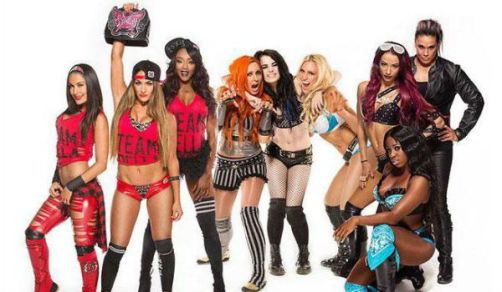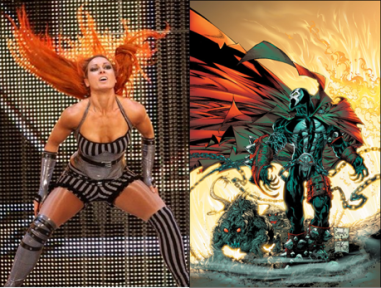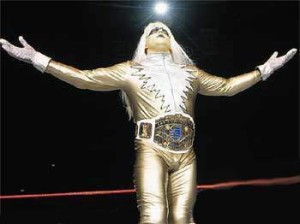What has become clear in the Network era of the WWE is that prime-time television shows are simply commercial-filled commercials for the 3-hour Network PPV which in turn is just a commercial for the next PPV in a month-by-month subscription economy. Gone is the idea of quality wrestling driving an audience to return to see more quality wrestling. That’s too unpredictable; tastes can change and the WWE would need to stay consistently innovative and that’s difficult, risky and definitely cost ineffective. Instead the “WWE Universe” is now a consumer body marketed to with symbols and logos in an exercise of high-end branding superiority.
There is no better example of this depressing shift in corporate culture than the Divas Revolution. The WWE has been successful in coining that hashtag phrase even though the women’s wrestling on the main WWE roster has yet to show any signs of improving. The significance of that terminology remains important because it demonstrates the marketing power of the WWE and just how little actual wrestling matters to the commercialisation of sports entertainment.
However, I still believe the Divas Revolution will be historic. Professional wrestling has never seen anything quite as ridiculous as the current sea of overflowing hair extensions worn by the WWE’s female wrestlers. This quote unquote “revolution” was explained as a step towards improving the women’s wrestling division in the WWE, yet what we see on the screen does not match exactly what we’re being told. One cannot deny the presence of these monstrous hair extensions and I think when we look back in 10 years, this cartoonish fad and sexist look will stand out just as significantly dated as the melon-ous breast implants that were on display in the 90s.
Thanks to that WWE Network, it’s easier than ever to roll your eyes at the different era-specific fashion trends. We can all see the blown-up muscles of the 80s (and the more cringe-worthy return in the mid-2000s), along with florescent tassels, cozy singlets and bubble letters. In the 90s there was that “extreme” look of denim and t-shirts, and in the 2000s there was an endless stream of trunks splattered with tribal tattoo patterns. The 20-teens are going to definitely be known for these waterfalls of hair extensions weighing down the Divas like capes from a Todd McFarlane comic.
If you hadn’t noticed the hair extensions before then I apologise because what I just did was force you to wear the alien-exposing sunglasses from They Live (minus the alley fight). You’ll never be able to watch another monotonous 6-woman tag team match on RAW the same again.
There is no chance that this organised and uniform change across the Diva roster is a coincidence. The specific styles and colours used for each woman is the current way the WWE tries to get you invest financially in an image. Good or bad performances in the ring matter less than whipping that hair around so that you can recognise that the #DivasRevolution is a thing that is happening. While it’s easy to point to a handful of great NXT women’s matches in 2015, the subsequent television time on the main WWE brand due to the Divas Revolution has not resulted in a single noteworthy match or performance. This increased television time is merely a device to get all this hair in front of your eyes in order to sell you on the package of a subscription-based sports entertainment serialised commercial. There is no denying that women are included when you purchase your Network subscription because you’ve seen all that hair! Young women demographic – check. Hardcore male wrestling fan demographic – check.
The comparison to the artistic capes of one Todd McFarlane does not stop at the ludicrously unrealistic size and shape of these forms. McFarlane was a founder of Image Comics, who started another ‘revolution’ by launching an entire line of comics based on the eye-catching work of artists. No doubt, the success of Image in competition with Marvel and DC was entirely thanks to the exaggerated body shapes and clothing instead of content or story. Is this the model the WWE is currently using to make their streaming service stand-out in an enormously competitive marketplace?
Unfortunately (for old school wrestling fans only I suppose) this trend is not exclusive to the Divas ‘division’. Brock Lesnar, the major selling point for the brand in 2015, continues to confuse good wrestling matches with the portrayal of a good “monster” wrestler, while the Undertaker and Sting are being used despite their age and ability in order to apparently drive up subscriptions numbers each month through their sheer symbolic and iconic appearances. New stars like Bray Wyatt, Roman Reigns, or even ‘workrate’ favourites Seth Rollins and Dean Ambrose, are more about selling a physical persona than building one through in-ring excellence.
Only John Cena continues to perform at a traditionally quantifiable high workrate level, which is either a testament to his backstage power or simply a way to pacify the man who propped up the entire company for the past 10 years with his epic pay-per-view main event performances. He may be the last of his kind; the Rollins’ and Reigns’ to come from this point forward will all have been spun out of the Network era and will never have the influence a HHH, Cena or Orton do today. You might train to be NXT Sasha Banks but when you move up you’ll have to be WWE Sasha Banks, with your own unique hair extension colour and wispy shape, and you’ll do it because that’s what Sasha Banks did.
No doubt, the fear many sense in the quick ascension of the spectacularly red-haired Eva Marie is due to the acknowledgement most fans at least must possess subconsciously that the #HairExtensionRevolution is much more powerful than the lip service of the #DivasRevolution.
For every Sasha Banks vs. Bayley NXT main event there’s now going to be a dozen Sasha Banks vs. Paige matches on RAW. The promise of what you saw (or heard of) in NXT combined with the push of the ‘Divas Revolution’ and these toy-store hair extensions allow the WWE to keep the audience aware of this new revenue stream. Actual wrestling would be the one thing that could hurt what the WWE now sells because of injuries, damage to appearance or even worse, ruining that hair. As we’ve seen in the past couple of years, the WWE banks on a perpetual anticipation of something good happening to maintain their subscription service. This is a risky move because how long will audience complacency allow them to keep walking this razor’s edge? So far so good, since no one seems to notice these ridiculous hair extensions… yet.





